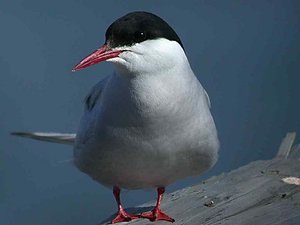

Arctic tern in flight via Wikimedia Commons.
The bird that flies farthest is the Arctic tern, an elegant white seabird. This bird also sees more daylight than any other.
The Arctic tern breeds on the shores of the Arctic Ocean in the Northern Hemisphere summer. And it feeds over the oceans of the Southern Hemisphere half a year later – in Southern Hemisphere summer. So, like many birds, this bird flies great distances every year to maintain its life of endless summertime.
North American Arctic terns fly about 24,000 miles (40,000 km) each year. That’s a distance about equal to the distance around the Earth.
An Arctic tern can live for 25 years, so in its life-long quest for summer it can fly a million kilometers (620,000 miles) – nearly three times the distance from the Earth to the moon.
By the way, there are about 120 migratory bird species with populations in the United States and south of the equator. Most of these species cross the equator during migration. For example, the red knot flies from New England to far southern South America.
Other birds stay in one hemisphere, but go farther. For example, the wandering albatross spends most of its life aloft, circling the world over the oceans of the Southern Hemisphere. It stops only to breed on storm-swept islands near Antarctica.
A wandering albatross might fly 30,000 kilometers – that’s 18,000 miles – between breedings.
So while the Arctic tern flies farthest of all birds, there are other bird species that come in a close second!
Bottom line: The Arctic tern is the bird that migrates the farthest.
from EarthSky https://ift.tt/1HGx5Kr


Arctic tern in flight via Wikimedia Commons.
The bird that flies farthest is the Arctic tern, an elegant white seabird. This bird also sees more daylight than any other.
The Arctic tern breeds on the shores of the Arctic Ocean in the Northern Hemisphere summer. And it feeds over the oceans of the Southern Hemisphere half a year later – in Southern Hemisphere summer. So, like many birds, this bird flies great distances every year to maintain its life of endless summertime.
North American Arctic terns fly about 24,000 miles (40,000 km) each year. That’s a distance about equal to the distance around the Earth.
An Arctic tern can live for 25 years, so in its life-long quest for summer it can fly a million kilometers (620,000 miles) – nearly three times the distance from the Earth to the moon.
By the way, there are about 120 migratory bird species with populations in the United States and south of the equator. Most of these species cross the equator during migration. For example, the red knot flies from New England to far southern South America.
Other birds stay in one hemisphere, but go farther. For example, the wandering albatross spends most of its life aloft, circling the world over the oceans of the Southern Hemisphere. It stops only to breed on storm-swept islands near Antarctica.
A wandering albatross might fly 30,000 kilometers – that’s 18,000 miles – between breedings.
So while the Arctic tern flies farthest of all birds, there are other bird species that come in a close second!
Bottom line: The Arctic tern is the bird that migrates the farthest.
from EarthSky https://ift.tt/1HGx5Kr




Aucun commentaire:
Enregistrer un commentaire